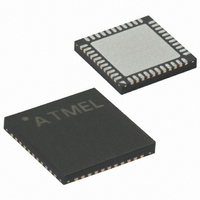ATXMEGA16A4-MH Atmel, ATXMEGA16A4-MH Datasheet - Page 16

ATXMEGA16A4-MH
Manufacturer Part Number
ATXMEGA16A4-MH
Description
MCU AVR 16K FLASH 1.6V 44-QFN
Manufacturer
Atmel
Series
AVR® XMEGAr
Datasheet
1.ATXMEGA16A4-CUR.pdf
(108 pages)
Specifications of ATXMEGA16A4-MH
Core Processor
AVR
Core Size
8/16-Bit
Speed
32MHz
Connectivity
I²C, IrDA, SPI, UART/USART
Peripherals
Brown-out Detect/Reset, DMA, POR, PWM, WDT
Number Of I /o
34
Program Memory Size
16KB (8K x 16)
Program Memory Type
FLASH
Eeprom Size
1K x 8
Ram Size
2K x 8
Voltage - Supply (vcc/vdd)
1.6 V ~ 3.6 V
Data Converters
A/D 12x12b, D/A 2x12b
Oscillator Type
Internal
Operating Temperature
-40°C ~ 85°C
Package / Case
44-VQFN Exposed Pad
Processor Series
ATXMEGA16x
Core
AVR8
Data Bus Width
8 bit, 16 bit
Data Ram Size
2 KB
Interface Type
I2C, SPI, USART
Maximum Clock Frequency
32 MHz
Number Of Programmable I/os
36
Number Of Timers
5
Operating Supply Voltage
1.6 V to 3.6 V
Maximum Operating Temperature
+ 85 C
Mounting Style
SMD/SMT
3rd Party Development Tools
EWAVR, EWAVR-BL
Development Tools By Supplier
ATAVRDRAGON, ATAVRISP2, ATAVRONEKIT
Minimum Operating Temperature
- 40 C
On-chip Adc
12 bit, 1 Channel
On-chip Dac
2 bit, 1 Channel
Package
44VFBGA EP
Device Core
AVR
Family Name
XMEGA
Maximum Speed
32 MHz
For Use With
ATAVRONEKIT - KIT AVR/AVR32 DEBUGGER/PROGRMMRATSTK600-TQFP44 - STK600 SOCKET/ADAPTER 44-TQFP770-1007 - ISP 4PORT ATMEL AVR MCU SPI/JTAG770-1004 - ISP 4PORT FOR ATMEL AVR MCU SPIATAVRISP2 - PROGRAMMER AVR IN SYSTEM
Lead Free Status / RoHS Status
Lead free / RoHS Compliant
Other names
ATXMEGA16A4-MU
ATXMEGA16A4-MU
ATXMEGA16A4-MU
9. Event System
9.1
9.2
8069Q–AVR–12/10
Features
Overview
•
•
•
•
•
•
•
•
The Event System is a set of features for inter-peripheral communication. It enables the possibil-
ity for a change of state in one peripheral to automatically trigger actions in one or more
peripherals. Whose changes in a peripheral that will trigger actions in other peripherals are con-
figurable by software. It is a simple, but powerful system as it allows for autonomous control of
peripherals without any use of interrupts, CPU or DMA resources.
The indication of a change in a peripheral is referred to as an event, and is usually the same as
the interrupt conditions for that peripheral. Events are passed between peripherals using a dedi-
cated routing network called the Event Routing Network.
block diagram of the Event System with the Event Routing Network and the peripherals to which
it is connected. This highly flexible system can be used for simple routing of signals, pin func-
tions or for sequencing of events.
The maximum latency is two CPU clock cycles from when an event is generated in one periph-
eral, until the actions are triggered in one or more other peripherals.
The Event System is functional in both Active and Idle modes.
Inter-peripheral communication and signalling with minimum latency
CPU and DMA independent operation
8 Event Channels allow for up to 8 signals to be routed at the same time
Events can be generated by
Events can be used by
The same event can be used by multiple peripherals for synchronized timing
Advanced Features
Functions in Active and Idle mode
– TImer/Counters (TCxn)
– Real Time Counter (RTC)
– Analog to Digital Converters (ADCx)
– Analog Comparators (ACx)
– Ports (PORTx)
– System Clock (Clk
– Software (CPU)
– TImer/Counters (TCxn)
– Analog to Digital Converters (ADCx)
– Digital to Analog Converters (DACx)
– Ports (PORTx)
– DMA Controller (DMAC)
– IR Communication Module (IRCOM)
– Manual Event Generation from software (CPU)
– Quadrature Decoding
– Digital Filtering
SYS
)
Figure 9-1 on page 17
XMEGA A4
shows a basic
16












